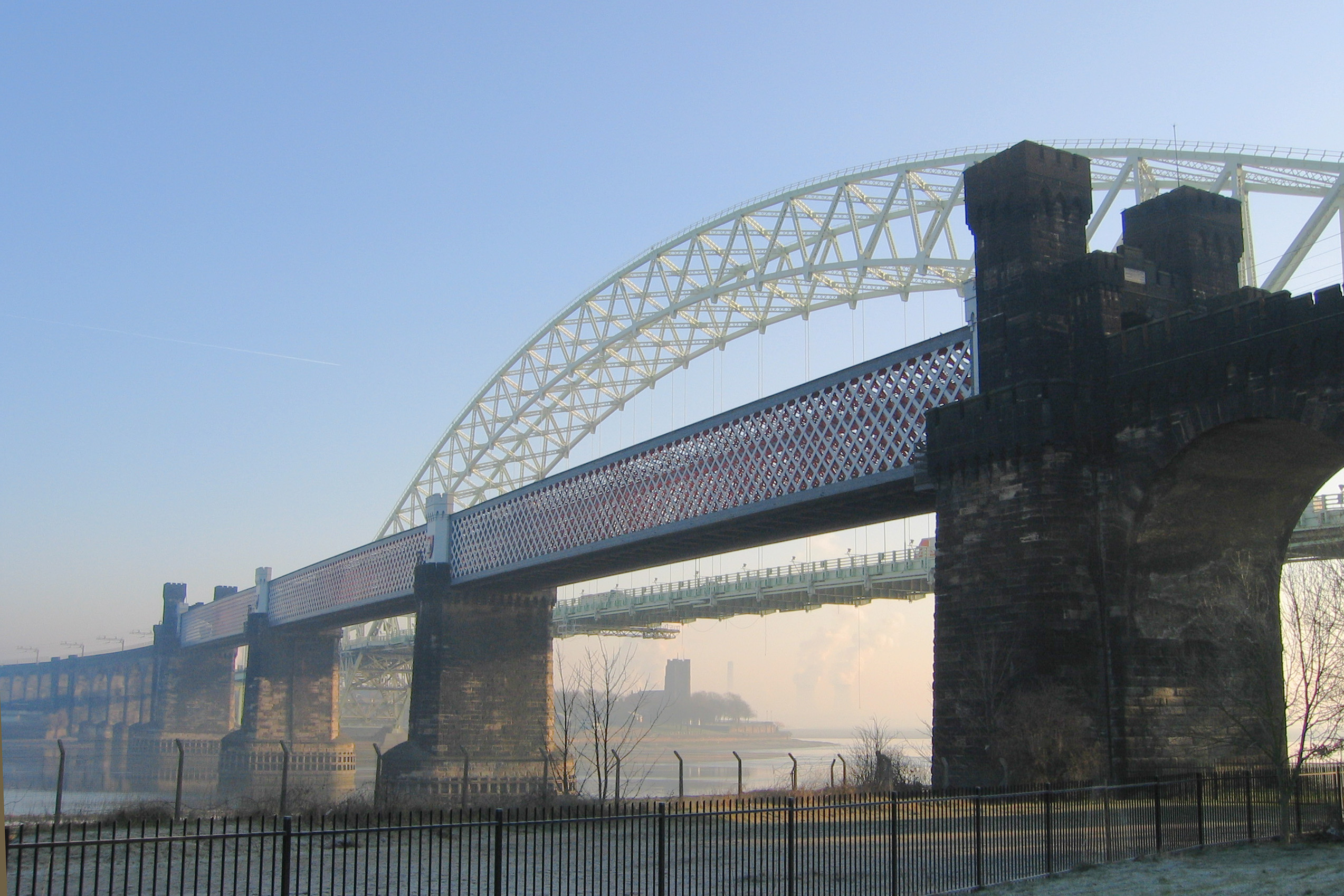- Runcorn Railway Bridge
Infobox_Bridge
bridge_name=Runcorn Railway Bridge
caption=Runcorn Railway Bridge
official_name=
carries=Liverpool branch of theWest Coast Main Line
crosses=River Mersey
locale=Runcorn ,Cheshire
maint=
id=
design=
designer= William Baker
mainspan=
length=
width=
height=
load=
clearance=
below=convert|75|ft|m|0
traffic=
open=1868
closed=
toll=None
troll=
map_cue=
map_
map_text=
map_width=
lat= 53.346158
long= -2.73772The Runcorn Railway Bridge crosses the
River Mersey at Runcorn Gap fromRuncorn toWidnes inCheshire ,England . It was built for theLondon and North Western Railway to a design by William Baker, chief engineer of the railway company.Cowan, C. A. "Crossing the Runcorn Gap, Vol. 3: Runcorn Railway Bridge", Halton Borough Council, 1990.] It is a Grade II*listed building . [http://www.imagesofengland.org.uk/search/details.aspx?pid=1&id=56057 Images of England] , accessed17 July 2007 ]History
In 1846 the
Grand Junction Railway Company obtained anAct of Parliament to build abridge to cross Runcorn Gap. A time limit of 7 years was imposed. Shortly after obtaining the Act the Company amalgamated with others to form the London and North Western Railway. Other projects took precedence, the 7 years time limit passed, and so the powers to build the bridge lapsed.In 1861 Parliamentary approval for a bridge was again obtained as part of building a line from Aston, to the south-east of Runcorn where it joined the line from
Crewe toWarrington atWeaver Junction , to the west of Widnes, where it joined the line from Warrington toGarston atDitton Junction. Work commenced in 1863 and the first stone was laid in 1864. The bridge was completed by 1868 and on May 21st there was an introductory opening when the contractor's locomotive 'Cheshire' drew 20 wagons over the bridge.Starkey, H. F. "Old Runcorn", Halton Borough Council, 1990, p. 170.] It was formally opened for traffic on 10th October. The first goods traffic crossed it onFebruary 1 1869 and the first passenger train crossed on April 1st of that year.The bridge consists of three
wrought iron spans of convert|305|ft|m|0, each on twosandstone abutment s with foundations at a depth of about convert|45|ft|m|0 below water level. It carries a double line of tracks, with a footpath for pedestrians on its eastern side. It has a clearance of convert|75|ft|m|0 above the high water mark to allow sailing ships to pass beneath it. There are 6lattice girder s, two to each span. Each girder contains 700 tons of iron and is fastened by 48,115 rivets. From the north side of the river the bridge is approached by a viaduct of 49 arches, then a short piece of embankment, followed by 16 more arches. From the south it is approached by a viaduct of 33 arches. On its completion, the bridge was the longest of its time. [cite web | title= West Bank Promenade Conservation Area | publisher= Halton Borough Council | url= http://www2.halton.gov.uk/pdfs/environment/planning/westbankpromenade | format=PDF | accessdate= 2007-08-19]The bridge is named after Aethelfleda because the southern abutments and pier were built on the site of the Saxon castle erected by her in 915. Parts of the bridge are
castellated to reflect this. There are three shields above the footway showing, from the southern end, theCoat of Arms of theCity of London ,Britannia (from the crest of the railway company) and theLiver Bird ofLiverpool . Because of the crest the bridge is also known as the Britannia Railway Bridge.In the 1890s the
Manchester Ship Canal was built, passing under the bridge. The footway was closed in 1965. The bridge is still in use today for rail traffic on theLiverpool branch of theWest Coast Main Line .References
ee also
*
Listed buildings in Runcorn, Cheshire Further reading
*"The Bridging of Runcorn Gap", Halton Borough Council, 1978
*Cowan, C. A. "Crossing the Runcorn Gap, Vol. 1: Runcorn Ferry and Hale Ford", Halton Borough Council, 1990.
*Cowan, C. A. "Crossing the Runcorn Gap, Vol. 2: Early Bridging Proposals", Halton Borough Council, 1992.
*Thompson, Dave. "Bridging the Mersey: A Pictorial History", European Library, Zaltbommel, 2000.
Wikimedia Foundation. 2010.
